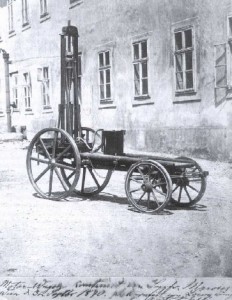By Samuel Ludlow
“The word automobile was not a revolutionary term. What made the automobile revolutionary was adding a power source to move the vehicles” (Sinclair Jr., 1946/1947).
18th Century – Steam
The European automobile industry began as early as 1769. A French engineer named Nicolas Joseph Cugnot developed the first self-propelled steam road-vehicle (Sinclair Jr., 1946/1947) . Two years after Cugnot developed this self-propelled vehicle, the army wanted to commission it for practical purposes. The newly developed automobile was used for the French army to carry around very large and very heavy cannons (The Lotus Leaf: Evolution and Standardisation of the Automobile, 1916). In January of 1784, Britain engineer Murdoch made the first working model of a steam engine carriage.

Steam powered Fardier de CugnotName
by 2013 Tampa Bay Auto Museum, used under 
The adaptation of the steam engine impacted the way agricultural, economic, and transportation processes were carried (Derek Rayner). Steam powered vehicles had some drawbacks. People were weary to ride in an automobile with a boiler full of steam under their seat (Sinclair Jr., 1946/1947). According to Sinclair Jr., another common problem with the steam engine was constantly running out of steam.
19th Century – Electric, Fossil Fuels
The first working electric automobile was built in 1832. These vehicles were heavy, slow, expensive, and needed to stop for recharging frequently (Ludwigson, 1967). Electric cars used rechargeable batteries that powered a small electric motor. These cars were able to reach a whopping four miles an hour. The problem with building electric automobiles is the practicality of the issue. It doesn’t do much good if a vehicle can’t go faster than a brisk walk. There is also the issue of distance. It isn’t realistic to have to recharge a car after very short drives. Because of these issues, the combustion engine became much more popular.
Jean Joseph Étienne Lenoir invented an internal combustion engine that was fueled by coal gas in 1858 (History of the Automobile). In 1879, Siegfried Samuel Marcus was the first man to propel a car with gasoline (Bryant, 1971). Despite his best efforts, the first Marcus car was only able to move a few yards at a time.

The First Marcus Car Propelled by Gasoline
by Wikimedia, used under 
In 1888, the first gasoline powered commercial automobile was made in Germany by Karl Benz (History of the Automobile).
